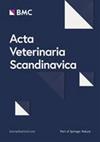通过共面显微镜和液滴数字聚合酶链反应评估挪威羔羊胃肠道线虫的发生率
IF 1.9
2区 农林科学
Q2 VETERINARY SCIENCES
引用次数: 0
摘要
胃肠道线虫(GINs)对全世界绵羊的生产、健康和福利都有重大影响。挪威也不例外,但有关挪威绵羊胃肠道线虫流行情况的研究却寥寥无几。这项研究的目的是调查目前挪威羊群中最重要的线虫的发生情况。研究人员于2021/2022年从羊群中采集了粪便样本,这些样本主要来自挪威的三个地理区域,即北部、东部和西部。在所包括的 134 个羊群中,每个羊群都采集了 10 只羔羊(秋季)的个体样本。从汇集的样本中培养和收获第三期幼虫(L3)(Baermann 法)。然后提取 DNA,并使用液滴数字 PCR(ddPCR)进行进一步分析。这样就能评估三个最重要的线虫种类/属(即 H. contortus、T. circumcincta 和 Trichostrongylus)的比例。通过使用通用的强喙线虫引物和物种/属特异性引物及探针组进行双链检测,评估了各物种/属的丰度/相对比例。此外,还通过标准粪卵计数法(即麦克马斯特法)评估了线虫卵的发生率。在134个采样群中,24个来自挪威北部地区,31个来自挪威东部地区,71个来自挪威西部地区。此外,还有一些来自挪威中部(7只)和南部(1只)的鸡群。在采样的鸡群中,圆线虫(T. circumcincta)最常见(94%),其次是线虫(H. contortus)(60%)和旋毛虫(Trichostrongylus)(55%)以及线虫(Nematodirus)(51%)。一般情况下,会出现混合感染,分别有 38% 和 18% 的鸡群感染了三种或所有四种虫属。这项研究结果表明,GINs在挪威很普遍。根据筛查结果,大多数鸡群似乎都感染了Teladorsagia circumcincta。此外,研究结果表明,线虫属(Nematodirus spp.)在全国范围内感染羔羊,主要是巴氏线虫(N. battus),并表明这种线虫的数量越来越多,这可能会导致线虫病的增加。本文章由计算机程序翻译,如有差异,请以英文原文为准。
Occurrence of gastrointestinal nematodes in lambs in Norway, as assessed by copromicroscopy and droplet digital polymerase chain reaction
Gastrointestinal nematodes (GINs) have a major impact on sheep production, health, and welfare worldwide. Norway is no exception, but there are only a few studies on the prevalence of GINs in Norwegian sheep. The aim of this study was to investigate the current occurrence of the most important nematodes in sheep flocks in Norway. Faecal samples were collected from flocks in 2021/2022, mainly from three geographical regions in Norway, i.e., northern, eastern, and western. In each of 134 flocks included, individual samples from 10 lambs (autumn) were pooled. Third stage larvae (L3) were cultivated and harvested (Baermann method) from the pooled samples. The DNA was then extracted and further analysed using droplet digital PCR (ddPCR). This enables assessment of the proportions of the three most important nematode species/genera, i.e., H. contortus, T. circumcincta, and Trichostrongylus. The fractional abundance/relative proportion of each species/genus was assessed by performing duplex assays with universal strongyle and species/genus-specific primers and probe sets. In addition, the occurrence of Nematodirus eggs was assessed by standard faecal egg counts (i.e., McMaster method). Of the 134 flocks sampled, 24 were from the northern region, 31 from eastern, and 71 from western Norway. In addition, some flocks from central (n = 7), and southern (n = 1) Norway were included. Among the sampled flocks, T. circumcincta occurred most commonly (94%), followed by H. contortus (60%) and Trichostrongylus (55%), and Nematodirus (51%). In general, mixed infections were observed, with 38% and 18% of flocks infected with three or all four genera, respectively. The results of this study indicate that GINs are widespread in Norway. Teladorsagia circumcincta seems to be present in most flocks based on this screening. Moreover, the results show that Nematodirus spp. infect lambs throughout the country, predominantly N. battus, and indicate that this nematode has become more abundant, which could lead to an increase in nematodirosis.
求助全文
通过发布文献求助,成功后即可免费获取论文全文。
去求助
来源期刊

Acta Veterinaria Scandinavica
农林科学-兽医学
CiteScore
3.60
自引率
0.00%
发文量
28
审稿时长
18-36 weeks
期刊介绍:
Acta Veterinaria Scandinavica is an open access journal encompassing all aspects of veterinary research and medicine of domestic and wild animals.
 求助内容:
求助内容: 应助结果提醒方式:
应助结果提醒方式:


